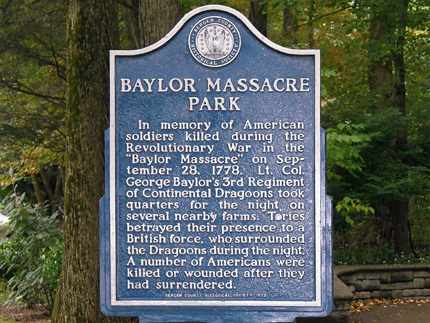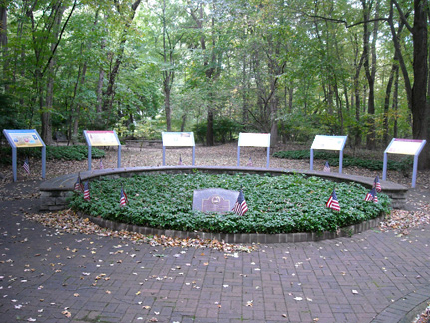





Baylor Massacre Park
Red Oak Dr. and River Vale Rd.
Map / Directions to Baylor Massacre Park
This park is dedicated to the events that occurred in this area on the evening of September 27 into September 28, 1778, in which members of Lt. Col. George Baylor's Third Regiment of Continental Dragoons were killed or wounded by British soldiers after having surrendered.

Colonel George Baylor
Commander of the Third Regiment of Continental Light Dragoons
Colonel George Baylor was the son of a wealthy and influential Virginia planter named John Baylor who had served with George Washington in the French and Indian War. Washington was a frequent visitor to the Baylor plantation, where John raised race horses, and so he knew George before the Revolutionary War. When the war began in 1775, General George Washington appointed George as his first aide-de-camp. (An aide-de-camp is an officer who serves as a General's assistant). [1]
Captain Baylor served at the December 26, 1776 Battle of Trenton, accepting the surrender of a group of Hessian soldiers. He had the honor of delivering General Washington's letter about the victory to the Continental Congress. Washington closed the letter with praise for Baylor, which shows the high regard Washington must have had for him. The Battle Of Trenton was Washington's own great triumph in the war up to that point [2]. And yet when he writes Congress of the victory, he goes out of his way to praise his aide-de-camp Baylor by writing, "Colonel Baylor, my first aid de camp, will have the honour of delivering this to you, and from him you may be made acquainted with many particulars; his spirited behaviour, upon every occasion, requires me to recommend him to your particular notice." [3]
Two weeks later, on January 9, 1777, Washington wrote from his headquarters in Morristown to Baylor, regarding Baylor's having been given his own command of a regiment of light cavalry, Third Continental Light Dragoons. In it Washington wrote, "Your inclination to command a regiment of horses I cheerfully yield to, because it is the recommendation of Congress, your own wish, and my desire." [4]

Baylor Massacre - September 28, 1778
"Savage Cruelty" [5]
This area was known as Overkill at the time. The name came from the phrase, “Over de kill,” which referred to a bridge which ran over the creek that connects with the Hackensack River. (The Dutch word "Kill" referred to a river or creek. Many people of Dutch descent lived in Bergen County.) The main road, which led to New York State, was called Overkill Road; it is now called River Vale Road and is still a direct route to the New York border two-and-a-half miles north. The village contained a tannery (where animal skins were tanned and processed for use), and a millstone and in-ground vats along the Hackensack River.
On the evening of September 27, Colonel Baylor and his regiment stayed in Overkill. Baylor and one of his officers, Major Charles Clough, made their headquarters in a stone house on Overkill Road. The other officers used two other stone houses on this road, while the enlisted soldiers slept in six barns which were also located on this road. [6]
British troops under General Charles "No-Flint" Grey moved into the area, likely alerted to the presence of Baylor's troops by local Tories. (Grey had acquired the nickname "No-Flint" after an encounter in Paoli, Pennsylvania, in 1777, when he ordered his men to remove the flints from their guns and only use theirs bayonets during a surprise night attack on an American encampment.) [7]
General "No-Flint" Grey's troops approached from the south up Overkill Road, along the land now used by the Edgewood Country Club. A plaque in the park describes what happened next, early on September 28: [8]
"By one in the morning, “No-Flint” Grey’s troops had dispatched the guard Baylor had posted near the bridge. They surrounded the barns where the sleeping soldiers lay. Again, Grey’s men had removed the flints from their guns and stood with bayonets ready. They threw open the barn doors and attacked. Baylor's men quickly realized their hopeless situation.
"Gentlemen's rules of war called for defeated troops to receive “quarter”: if they surrendered, their lives would be spared. Unfortunately, not all soldiers are gentlemen. Eleven of Baylor’s Dragoons were stabbed repeatedly and killed, and another four died later. Thirty-three, some with wounds, were taken prisoner. The others escaped into the woods.
"British soldiers burst into the house where the officers slept. A British newspaper reported that Baylor and three of his officers tried to hide up a large Dutch chimney, but were quickly discovered. Major Clough was so severely wounded that he died the next day. Baylor was bayoneted in the thigh and groin, and taken captive."

Gravesite
Burial and Rediscovery
After the Baylor Massacre, six of the dead soldiers were buried in three abandoned wooden tanning vats near the stream that flows by here.
The remains of these six soldiers who died in the Baylor Massacre were discovered here in 1967. One of the six soldiers was identified as Sgt. Isaac Davenport, from his silver stock buckle discovered at the site. Unfortunately, the names of the other five men are unknown, and the graves of the other soldiers killed at the massacre have not been discovered. The remains of the six soldiers were re-interred next to the river, and the site was dedicated as a memorial park in 1972. [9]

Baylor Massacre Park contains a number of markers and plaques to explain and interpret the events surrounding the Baylor Massacre. A series of six historic plaques in the park tells the story of Baylor's Massacre and its aftermath in detail, complete with illustrations of paintings, original documents and a map.

1. ^ Biographical details about George Baylor and his father John were drawn from the first of a series of six historical plaques at Baylor Massacre Park. This marker is titled 'The Baylor Massacre' - September 28, 1778, and contains a section "Who was Baylor?"
2. ^ For more information and accompanying source notes about the Battle of Trenton, see the Trenton page of this website.
3. ^ George Washington's letter to The President of Congress, December 27, 1776:
George Washington; Edited by Jared Sparks The Writings of George Washington Volume 4 (New York: Harper & Brothers, 1847) p. 246-249
Available to be read at the Internet Archive Here
4. ^ George Washington's letter to Colonel George Baylor, January 9, 1777:
George Washington; Edited by Jared Sparks The Writings of George Washington Volume 4 (New York: Harper & Brothers, 1847) p. 269-270
Available to be read at the Internet Archive Here5. ^ The phrase "Savage Cruelty" was used to describe the Baylor Massacre by Dr. David Griffith in a letter he sent on October 20, 1778 to Lord Stirling, who was in charge of investigating the incident.
(Spelling has not been corrected or modernized.)
“The inclosed Testimony will shew that Congress was not misinformed respecting the Savage Cruelty attending the surprize of Colonel Baylors Regiment; in taking which, I do assure you, regard has been had, only, to essential facts, without taking notice of the many exagerating circumstances of inhumanity, such as Opprobrious Language without distinction; beating, even those they thought were mortally wounded, not excepting any of the Officers, And stripping every Man, in a very cool Night, of almost all their Cloths: All this is confirmed by the concurring Testimony of all the Officers and Men, & their Nakedness proves, in part, their Assertions."The full text of this letter can be found in the Founders Online section of the National Archives website here. The letter appears on the bottom half of the page. The top half of the page contains the text of a letter written by Colonel Baylor to General Washington on October 19, 1778. The bottom of the page links to several other letters pertaining to the Baylor Massacre that are available in the Founders Online section of the National Archives website.
6. ^ Information drawn from a plaque titled September 28, 1778 - A Night Of "Savage Cruelty," 'the fourth of a series of six historical plaques at Baylor Massacre Park.
7. ^ The 1777 attack that earned Grey the "No-Flint" nickname occurred in Paoli, PA, on September 20, 1777. British officer Major André recorded the incident in his journal, along with the rationale for removing the flints.
"Intelligence having been received of the situation of General Wayne and his design of attacking our rear, a plan was concerted for surprising him, and the execution entrusted to Major General Grey. The troops for this service were the 40th and 55th regiments, under colonel Musgrave, and the 2nd Battalion Light Infantry, the 42nd and 44th regiments under General Grey. General Grey's detachment marched at 10 o'clock at night, that under colonel Musgrave at 11. No soldier of either was suffered to load; those who could not draw their pieces took out the flints. We knew nearly the spot where the rebel corps lay, but nothing of the disposition of their camp. It was represented to the men that firing discovered us to the enemy, hid them from us, killed our friends and produced a confusion favorable to the escape of the rebels and perhaps productive of disgrace to ourselves. On the other hand, by not firing we knew the foe to be wherever fire appeared and a charge ensured his destruction; that amongst the enemy those in the rear would direct their fire against whoever fired in front, and they would destroy each other. General Grey's detachment marched by the road leading to the White Horse, and took every inhabitant with them as they passed along. About three miles from camp they turned to the left and proceeded to the Admiral Warren, where, having forced intelligence from a blacksmith, they came in upon the out sentries, piquet and camp of the rebels. The sentries fired and ran off to the number of four at different intervals. The piquet was surprised and most of them killed in endeavoring to retreat. On approaching the right of the camp we perceived the line of fires, and the light infantry being ordered to form in front, rushed along the line putting to the bayonet all they came up with, and, overtaking the main herd of the fugitives, stabbed great numbers and pressed on their rear till it was thought prudent to order them to desist. Near 200 must have been killed, and a great number wounded. 71 prisoners were brought off; 40 of them badly wounded were left at different houses on the road. A major, a captain, and two lieutenants were amongst the prisoners. We lost Captain Wolfe killed and one or two private men; four or five were wounded, one an officer, Lieutenant Hunter of 52nd Light Company. It was about 1 o'clock in the morning when the attack was made, and the rebels were then assembling to move towards us, with the design of attacking our baggage. Colonel Musgrave marched a different way and took post on the Philadelphia Road at the Paoli. It was thought he would have first fallen in with their outposts. By our attacking them on the flank next to Colonel Musgrave's post, they retired the opposite way and his detachment saw nothing of them."
8. ^ Quoted text from a plaque titled titled September 28, 1778 - A Night Of "Savage Cruelty," 'the fourth of a series of six historical plaques at Baylor Massacre Park.
9. ^ Details about the discovery of the bodies, their re-interring and the dedication of the park were drawn from the fifth of a series of six historical plaques at Baylor Massacre Park. This marker is titled The Price of Freedom: A Patriot's Grave Marker.